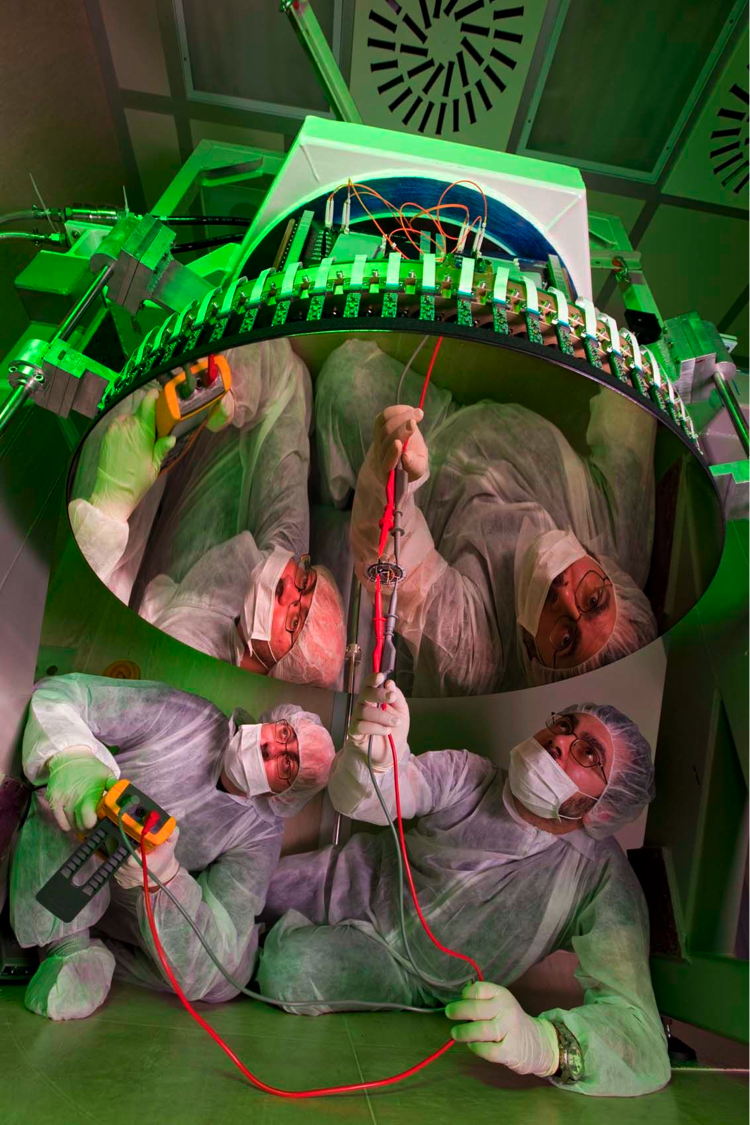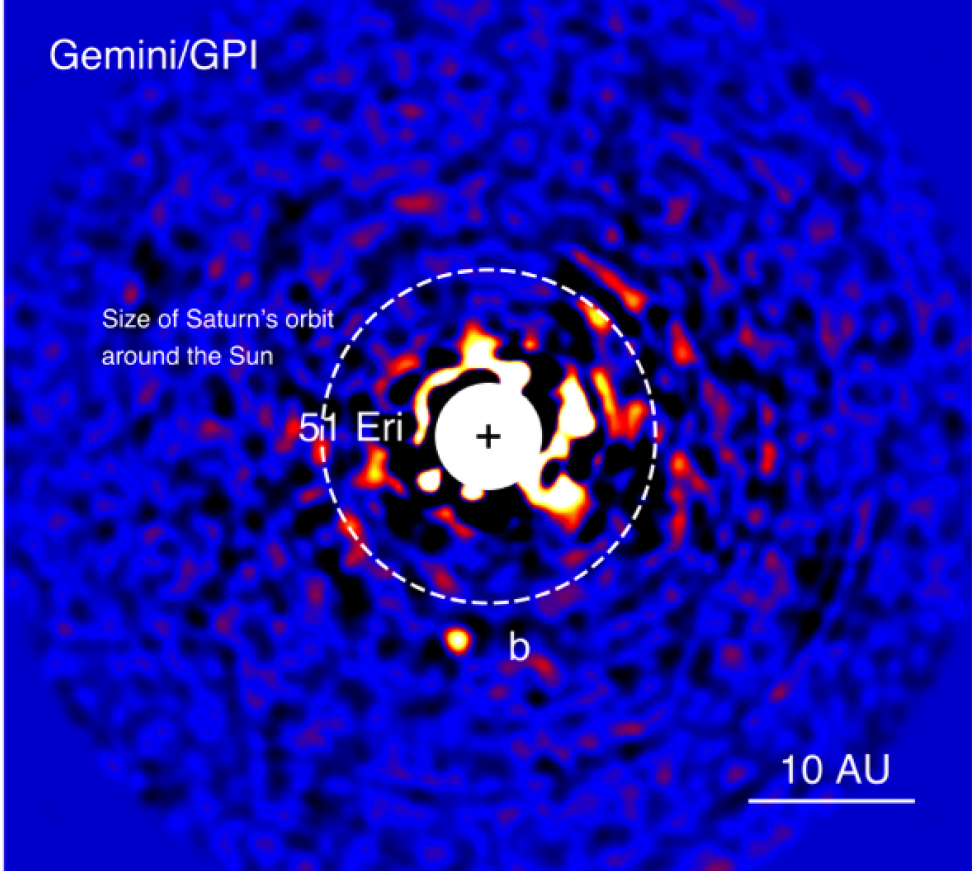Why Large, Ground-Based Telescopes?

While space telescopes make fantastic images, there are a number of reasons why big, ground-based telescopes are necessary for my work. The most straightforward is size. Space telescopes have traditionally been limited by the size of the space shuttle’s cargo bay – and so all space telescope mirrors launched to date have been around 1-3 meters in diameter.
In my work, I try to image things on VERY small angular scales, and the resolution limit for a telescope is inversely proportional to its diameter. That just means that the bigger a telescope is, the smaller the objects it can resolve. For example, in 2014 I used the 6.5 meter Magellan Clay telescope to image a planet that lies just 93 milli-arcseconds, or 0.00003 degrees, from it’s host star. You can learn more about this result and others on the “Results From My Science Research” page.
Telescopes also collect light according to their area, so a telescope that’s twice as large collects two squared, or four times, more light. This is necessary if you want to image very faint things (like exoplanets!). I do most of my work on ~8 meter telescopes, which is roughly 4 times the diameter of the Hubble Space Telescope. This means that I can collect 4 squared, or 16 times, more light, and image things that are 1/4 the size.
What is Adaptive Optics – How To De-Twinkle Stars

Ground-based observing has it’s disadvantages, the primary one being the Earth’s atmosphere. Although beautiful, twinkling stars are terrible for astronomical observing because twinkling amounts to the atmosphere dancing the image of a star around on your eye. Your eye sends a new image to your brain about ten times per second, and even between those tenths of seconds you notice twinkling, which tells you that the Earth’s atmosphere is varying on even shorter timescales.
Now imagine you could delay sending an image to your brain and collect light with your eye for a full minute. You’d collect much more light of course (60*10, or 600 times more), but you’d also lose information about the true location of the star because its image would move around over the course of the minute. Since astronomical cameras do just that, collect light over several seconds, minutes, or even hours in order to image faint things that your eye could never see, twinkling blurs images. If two objects are close together and you bounce their light around, they’ll blur together and you’ll no longer “resolve” them as separate objects.
In order to gain all of the resolution and light collection advantages of big telescopes, we need to correct somehow for twinkling, which we do with a technique called adaptive optics, or AO. An AO system has two key components – a wavefront sensor, which measures how light entering the telescope is bent by the earth’s atmosphere, and a deformable mirror, which bends to cancel out that measured aberration when distorted light bounces off of it.
Modern deformable mirrors can change their shape a thousand or more times per second. Here‘s a great movie of the LBTAO system in operation. You can see the camera reading out very fast (each image amounts to just a fraction of a second of light collection) and what looks like just a blur of light, which is the image of a star bouncing around on the screen as the atmosphere changes. As soon as the AO system starts running, you see that the image becomes rock steady – and you suddenly notice that there are in fact two separate stars there. Viola! High resolution imaging!
Direct Imaging – Why Take Pictures of Exoplanets?

Extrasolar planets, or exoplanets, are planets around other stars, and they are [I think] the most interesting of the small, faint things that we can see with big telescopes equipped with AO systems. Although there are many other complimentary ways to detect exoplanets, direct imaging is the only way of detecting planets where we see the planet itself rather than inferring its existence by observing its effect on the star it orbits. When I was a kid, exoplanets detected via any method were purely science fiction. Today, we’ve confirmed that there are thousands of them in our galaxy (see this website for the latest tally). It’s an amazing time to be involved in exoplanet research!
The planets we image are young (just a few million years old, which is very young in astronomical time), and harbor leftover heat from their formation, so they glow in infrared light. As you can imagine, collecting that planet light from right next to the star is non-trivial, since stars are much MUCH brighter than planets, even in the infrared. The brightness difference and separation with which we image exoplanets today is comparable to isolating the light of a firefly (~0.001 Watt) that is flying 1 foot away from a lighthouse (1,000 Watt) from 10 miles away (that translates to a contrast of 10^6 at 0.5 arcseconds).
We are currently in a golden era of exoplanetary science, where the success of various detection techniques, including direct imaging, has given us a large statistical sample of known exoplanets so that we can start to answer some really big human questions. Is the Earth unique or typical? Are there other pathways to habitable planets? Are there solar systems out there that look very different from our own?
The success of direct imaging in particular allows us to characterize planets around other stars for the first time, rather than merely detecting them. See the “Results From My Science Research” page to learn more about how I image exoplanets.
Holey Disks and Planet Formation

I also use large telescope to image the disks of material that surround young stars. These remnants of the star formation process are the sites of exoplanet formation. They are therefore an important source of information about when planets form, how they form, and what they’re made of.
I use AO systems to image disks at very high resolution which allows me to search for indirect signs (such as asymmetries) that indicate new planets or even new solar systems are in the process of forming within them. I am particularly interested in the class of disks known as “transitional disks”, which are missing material close to the star (they’re hollowed out in the middle like a doughnut). The goal of much of my dissertation research was to help illuminate the question of whether or not forming planets are responsible for making these clearings or if they could be explained by other processes. See the “Key Results from my Science Research” page for more about what I found.
